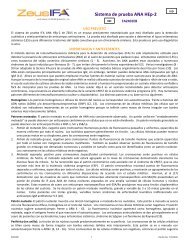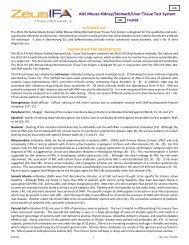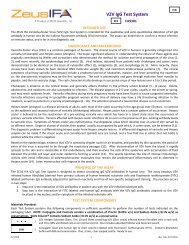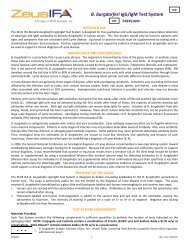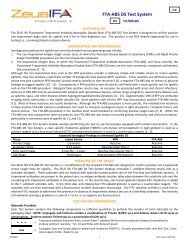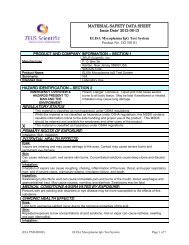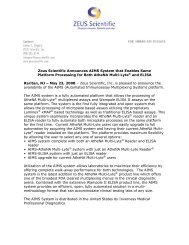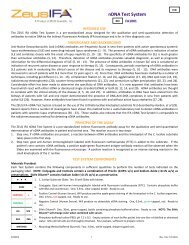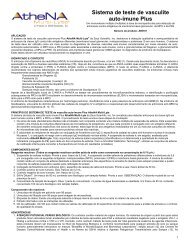ASMA Test System - ZEUS Scientific
ASMA Test System - ZEUS Scientific
ASMA Test System - ZEUS Scientific
You also want an ePaper? Increase the reach of your titles
YUMPU automatically turns print PDFs into web optimized ePapers that Google loves.
TM<br />
<strong>ASMA</strong> <strong>Test</strong> <strong>System</strong><br />
REF<br />
FA4001<br />
IVD<br />
INTENDED USE<br />
The <strong>ZEUS</strong> IFA Anti-Smooth Muscle Antibody (<strong>ASMA</strong>) <strong>Test</strong> <strong>System</strong> is designed for the qualitative and semi-quantitative detection of<br />
Smooth Muscle Antibodies (SMA) by the indirect fluorescent antibody (IFA) technique, and is for In Vitro diagnostic use.<br />
SIGNIFICANCE AND BACKGROUND<br />
Smooth Muscle antibodies were first described by Johnson, et al (1), and were thought to be specific for chronic active hepatitis.<br />
Although SMA are found in more than 50% of patients with chronic active hepatitis, they have also been found in association with<br />
primary biliary cirrhosis (2), asthma (3), and certain malignancies (4). SMA titers of 1:80 or greater that persist for several months to<br />
years are characteristically found in chronic active hepatitis (6). Patients with viral hepatitis, on the other hand, rarely have titers<br />
above 1:40, and only have transient trace amounts of SMA. The specific antigen for SMA appears to be actin or actin-like substances<br />
which may be present in liver cells (5). Until this report (5), it was difficult to reconcile the presence of SMA with chronic active liver<br />
disease. A more recent report has shown SMA to be an autoantibody - reactive with actin (7), the contractile substance of platelets,<br />
brush borders of epithelial cells and other substances (7).<br />
PRINCIPLE OF THE ASSAY<br />
The <strong>ZEUS</strong> IFA <strong>ASMA</strong> <strong>Test</strong> <strong>System</strong> is a pre-standardized assay designed to assess the level of SMA in human sera. The assay employs<br />
rat stomach tissue substrate and anti-human immunoglobulin Conjugate adjusted for optimum use dilution with minimum<br />
background staining. The reaction occurs in two steps:<br />
1. Step one involves the interaction of SMA in the patient’s sera with the smooth muscle antigen in the muscularis band basal to<br />
the glandular mucosa of the stomach.<br />
2. Step two is the reaction between the Conjugate and SMA attached to the smooth muscle antigen producing apple-green<br />
staining in a positive assay (see Assay Procedure section for details).<br />
TEST SYSTEM COMPONENTS<br />
Materials Provided:<br />
Each <strong>Test</strong> <strong>System</strong> contains the following components in sufficient quantities to perform the number of tests indicated on the<br />
packaging label. NOTE: Conjugate and Controls contain a combination of Proclin (0.05% v/v) and Sodium Azide (
3. The wells of the Slide do not contain viable organisms. However, consider the Slide potentially bio-hazardous materials and<br />
handle accordingly.<br />
4. The Controls are potentially bio-hazardous materials. Source materials from which these products were derived were found<br />
negative for HIV-1 antigen, HBsAg and for antibodies against HCV and HIV by approved test methods. However, since no test<br />
method can offer complete assurance that infectious agents are absent, these products should be handled at the Bio-safety<br />
Level 2 as recommended for any potentially infectious human serum or blood specimen in the Centers for Disease<br />
Control/National Institutes of Health manual “Biosafety in Microbiological and Biomedical Laboratories”: current edition; and<br />
OSHA’s Standard for Bloodborne Pathogens (20).<br />
5. Adherence to the specified time and temperature of incubations is essential for accurate results. All reagents must be allowed<br />
to reach room temperature (20 - 25°C) before starting the assay. Return unused reagents to their original containers<br />
immediately and follow storage requirements.<br />
6. Improper washing could cause false positive or false negative results. Be sure to minimize the amount of any residual PBS, by<br />
blotting, before adding Conjugate. Do not allow the wells to dry out between incubations.<br />
7. The SAVe Diluent ® , Conjugate, and Controls contain Sodium Azide at a concentration of
Transmitted Light<br />
Light Source: Mercury Vapor 200W or 50W<br />
Excitation Filter Barrier Filter Red Suppression Filter<br />
KP490 K510 or K530 BG38<br />
BG12 K510 or K530 BG38<br />
FITC K520 BG38<br />
Light Source: Tungsten – Halogen 100W<br />
KP490 K510 or K530 BG38<br />
Incident Light<br />
Light Source: Mercury Vapor 200, 100, 50 W<br />
Excitation Filter Dichroic Mirror Barrier Filter Red Suppression Filter<br />
KP500 TK510 K510 or K530 BG38<br />
FITC TK510 K530 BG38<br />
Light Source: Tungsten – Halogen 50 and 100 W<br />
KP500 TK510 K510 or K530 BG38<br />
FITC TK510 K530 BG38<br />
SPECIMEN COLLECTION<br />
1. <strong>ZEUS</strong> <strong>Scientific</strong> recommends that the user carry out specimen collection in accordance with CLSI document M29: Protection of<br />
Laboratory Workers from Occupationally Acquired Infectious Diseases. No known test method can offer complete assurance<br />
that human blood samples will not transmit infection. Therefore, all blood derivatives should be considered potentially<br />
infectious.<br />
2. Only freshly drawn and properly refrigerated sera obtained by approved aseptic venipuncture procedures with this assay (9, 10).<br />
No anticoagulants or preservatives should be added. Avoid using hemolyzed, lipemic, or bacterially contaminated sera.<br />
3. Store sample at room temperature for no longer than 8 hours. If testing is not performed within 8 hours, sera may be stored<br />
between 2 - 8°C, for no longer than 48 hours. If delay in testing is anticipated, store test sera at–20°C or lower. Avoid multiple<br />
freeze/thaw cycles which may cause loss of antibody activity and give erroneous results.<br />
STORAGE CONDITIONS<br />
Unopened <strong>Test</strong> <strong>System</strong>.<br />
Mounting Media, Conjugate, SAVe Diluent ® , Slides, Positive and Negative Controls.<br />
Rehydrated PBS (Stable for 30 days).<br />
Phosphate-buffered-saline (PBS) Packets.<br />
ASSAY PROCEDURE<br />
1. Remove Slides from refrigerated storage and allow them to warm to room temperature (20 - 25°C). Tear open the protective<br />
envelope and remove Slides. Do not apply pressure to flat sides of protective envelope.<br />
2. Identify each well with the appropriate patient sera and Controls. NOTE: The Controls are intended to be used undiluted.<br />
Prepare a 1:20 dilution (e.g.: 10µL of serum + 190µL of SAVe Diluent ® or PBS) of each patient serum. The SAVe Diluent ® will<br />
undergo a color change confirming that the specimen has been combined with the Diluent.<br />
Dilution Options:<br />
a. Users may titrate the Positive Control to endpoint to serve as a semi-quantitative (1+ Minimally Reactive) Control. In such<br />
cases, the Control should be diluted two-fold in SAVe Diluent ® or PBS. When evaluated by <strong>ZEUS</strong> <strong>Scientific</strong>, an endpoint<br />
dilution is established and printed on the Positive Control vial (± one dilution). It should be noted that due to variations<br />
within the laboratory (equipment, etc.), each laboratory should establish its own expected end-point titer for each lot of<br />
Positive Control.<br />
b. When titrating patient specimens, initial and all subsequent dilutions should be prepared in SAVe Diluent ® or PBS only.<br />
3. With suitable dispenser (listed above), dispense 20µL of each Control and each diluted patient sera in the appropriate wells.<br />
4. Incubate Slides at room temperature (20 - 25°C) for 30 minutes.<br />
5. Gently rinse Slides with PBS. Do not direct a stream of PBS into the test wells.<br />
6. Wash Slides for two, 5 minute intervals, changing PBS between washes.<br />
7. Remove Slides from PBS one at a time. Invert Slide and key wells to holes in blotters provided. Blot Slide by wiping the reverse<br />
side with an absorbent wipe. CAUTION: Position the blotter and Slide on a hard, flat surface. Blotting on paper towels may<br />
destroy the Slide matrix. Do not allow the Slides to dry during the test procedure.<br />
8. Add 20µL of Conjugate to each well.<br />
9. Repeat steps 4 through 7.<br />
R2315EN 3 (Rev. Date 7/3/2013)
10. Apply 3 - 5 drops of Mounting Media to each Slide (between the wells) and coverslip. Examine Slides immediately with an<br />
appropriate fluorescence microscope.<br />
NOTE: If delay in examining Slides is anticipated, seal coverslip with clear nail polish and store in refrigerator. It is recommended<br />
that Slides be examined on the same day as testing.<br />
QUALITY CONTROL<br />
1. Every time the assay is run, a Positive Control, a Negative Control and a Buffer Control must be included.<br />
2. It is recommended that one read the Positive and Negative Controls before evaluating test results. This will assist in establishing<br />
the references required to interpret the test sample. If Controls do not appear as described, results are invalid.<br />
a. Negative Control - characterized by the absence of bold fluorescent staining of the muscularis mucosa of the rat stomach<br />
substrate (flat green or reddish coloration).<br />
b. Positive Control - characterized by apple-green fluorescent staining of the longitudinal myofilament, also known as the<br />
muscularis mucosa of the rat stomach muscle.<br />
3. Additional Controls may be tested according to guidelines or requirements of local, state, and/or federal regulations or<br />
accrediting organizations.<br />
NOTES:<br />
a. The intensity of the observed fluorescence may vary with the microscope and filter system used.<br />
b. Non-specific reagent trapping may exist. It is important to adequately wash slides to eliminate false positive results.<br />
INTERPRETATION OF RESULTS<br />
1. Before results can be accurately interpreted, tissue section histology should be fully understood. Antigen/antibody reactions<br />
other than the primary antibody (SMA) initially sought may occur within the tissue substrate being used. Tissue<br />
antigen/antibody site identification, incorporating appropriate positive and negative controls, can often provide additional<br />
diagnostic information to the clinician. Antibodies to ANA, PCA, and MA can be detected using this substrate.<br />
a. Antinuclear Antibodies (ANA): In a positive assay, the anti-nuclear antibody in the patient’s serum interacts with the rat<br />
stomach chief and parietal cell nuclei producing an apple-green staining with the addition of the FITC conjugate.<br />
b. Parietal Cell Antibody (PCA): In a positive assay, the parietal cell antibody in the patient’s sera interacts with the rat<br />
stomach gastric parietal cells. With the addition of the FITC conjugate, an apple-green staining will occur.<br />
c. Mitochondrial Antibody (MA): In a positive assay, the mitochondrial antibody in the patient’s sera interacts with the chief<br />
and parietal cell cytoplasm. With the addition of the FITC conjugate, an apple-green staining will occur. A confirmatory test<br />
should be run using rat kidney substrate - the tissue of choice.<br />
2. Titers less than 1:40 are considered insignificant.<br />
3. Positive <strong>Test</strong>: Any observed apple-green staining of the muscularis of the rat stomach substrate at a 1:40 dilution based on a 1+<br />
to 4+ scale. 1+ is considered a weak reaction and 4+ a strong reaction.<br />
4. All sera positive at 1:20 should be titered to endpoint dilution. This is accomplished by making a 1:40, 1:80, 1:160, etc. serial<br />
dilution of all positives. The endpoint is the highest dilution that produces a positive apple-green staining reaction.<br />
LIMITATIONS OF THE ASSAY<br />
1. The <strong>ZEUS</strong> IFA <strong>ASMA</strong> <strong>Test</strong> <strong>System</strong> is a laboratory diagnostic aid and by itself is not diagnostic. Positive SMA may be found in<br />
diseases other than chronic active hepatitis (See Significance and Background section of this insert). It is therefore imperative<br />
that SMA results be interpreted by a medical authority.<br />
2. No definitive association between SMA staining and any specific disease state is intended with this product.<br />
EXPECTED RESULTS<br />
The expected value in the normal population is negative at a 1:20 dilution. However, apparently healthy individuals in the 5th to 7th<br />
decade of life may have positive SMA results (8).<br />
PERFORMANCE CHARACTERISTICS<br />
The <strong>ZEUS</strong> IFA <strong>ASMA</strong> <strong>Test</strong> <strong>System</strong> was evaluated in parallel with a reference procedure employing human stomach tissue substrate<br />
and the IFA procedure. Of the 69 sera tested by both methods, 28 were positive for SMA at a 1:40 or greater titer by both methods,<br />
and 41 were negative. There were 6 discrepancies between the two methods with respect to titer. The <strong>ZEUS</strong> procedure was one<br />
dilution higher in four specimens and one dilution lower in two specimens. There were no discrepancies with respect to the number<br />
of negative sera.<br />
REFERENCES<br />
1. Johnson GD, Holborow EJ, Glynn LE: Lancet 2:878, 1965.<br />
2. Holborow EJ: Br. Med. Bull. 28:142, 1972.<br />
3. Warwick MT, Haslam P: Clin. Exp. Immunol. 7:31, 1970.<br />
4. Whitehouse JM, Holborow EJ: Br. Med. J. 2:511, 1971.<br />
5. Farrow LJ, Holborow EJ, Brighton WD: Nature 231:186, 1971.<br />
6. Popper H, Schaffner F: Progress in Liver Diseases, Vol. IV. Grune and Stratton, NY, p. 381-402, 1972.<br />
7. Gabbian G, Ryan GB, Lamelin JP, et al: Am. J. Path. 72:473, 1973.<br />
R2315EN 4 (Rev. Date 7/3/2013)
8. Whittingham S, Irwin J, Mackay IR, et al: Aust. Ann. Med. 18:130, 1969.<br />
9. Procedures for the collection of diagnostic blood specimens by venipuncture - Second Edition; Approved Standard (1984). Published by National Committee for<br />
Clinical Laboratory Standards.<br />
10. Procedures for the Handling and Processing of Blood Specimens. NCCLS Document H18-A, Vol. 10, No. 12, Approved Guideline, 1990.<br />
11. U.S. Department of Labor, Occupational Safety and Health Administration: Occupational Exposure to Bloodborne Pathogens, Final Rule. Fed. Register 56:64175-<br />
64182, 1991.<br />
<strong>ZEUS</strong> <strong>Scientific</strong>, Inc.<br />
200 Evans Way, Branchburg, New Jersey, 08876, USA<br />
Toll Free (U.S.): 1-800-286-2111<br />
International: +1 908-526-3744<br />
Fax: +1 908-526-2058<br />
<strong>ZEUS</strong> IFA and SAVe DIluent ® are trademarks of <strong>ZEUS</strong> <strong>Scientific</strong>, Inc.<br />
Customer Service E-mail: orders@zeusscientific.com<br />
Technical Support E-mail: support@zeusscientific.com<br />
Website: www.zeusscientific.com<br />
© 2013 <strong>ZEUS</strong> <strong>Scientific</strong>, Inc. All Rights Reserved.<br />
R2315EN 5 (Rev. Date 7/3/2013)



